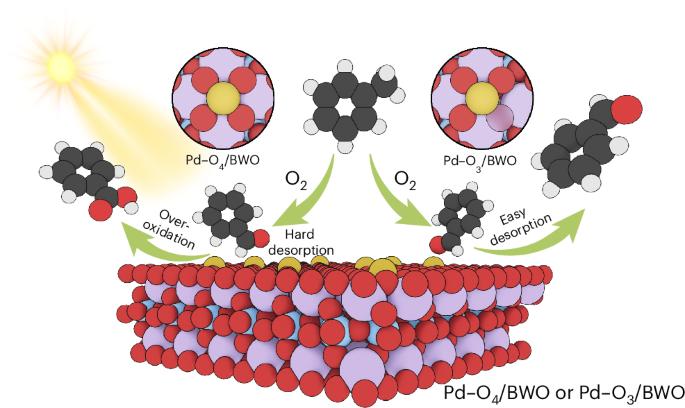Regulation of Pd single-atom coordination for enhanced photocatalytic oxidation of toluene to benzaldehyde
IF 20
0 CHEMISTRY, MULTIDISCIPLINARY
引用次数: 0
Abstract
Photocatalytic oxidation represents an effective means of hydrocarbon valorization, but achieving high-selectivity intermediate products at high substrate conversion remains challenging. Here single-atom Pd–O catalytic sites with different coordination environments are synthesized. The Pd–O3 coordinated single sites show the best catalytic performance for selective toluene oxidation, exhibiting a high benzaldehyde selectivity of 95% at 95% toluene conversion, and a benzaldehyde yield rate up to 12,000 μmol g−1 h−1, surpassing previously reported results. The Pd–O3 catalytic sites serve as the location of photogenerated charge separation and C(sp3)–H bond activation. These sites can trap the photogenerated holes effectively to enhance the charge-separation efficiency, improving the yield rate by a factor of 2.9 relative to the Bi2WO6 support. Additionally, the coordination structure weakens benzaldehyde adsorption, reducing overoxidation and improving reaction selectivity. This work highlights the importance of single-atom site coordination in optimizing the activity and selectivity of photocatalytic oxidation reactions. The design of active sites in single-atom photocatalysts has a large impact on the catalytic reactivity. Here single-atom Pd–O catalytic sites are engineered by regulating their coordination environments. The Pd–O3 sites exhibit enhanced activity and selectivity for photocatalytic oxidation of toluene to benzaldehyde.

Pd单原子配位对甲苯光催化氧化制苯甲醛的调控作用
光催化氧化是一种有效的碳氢化合物增值手段,但在高底物转化率下实现高选择性中间产物仍然具有挑战性。本文合成了具有不同配位环境的单原子Pd-O催化位点。Pd-O3配位单位点对甲苯的选择性氧化表现出最好的催化性能,在95%甲苯转化率下苯甲醛选择性高达95%,苯甲醛的产率高达12,000 μmol g−1 h−1,超过了先前报道的结果。Pd-O3催化位点是光生电荷分离和C(sp3) -H键活化的位置。这些位置可以有效地捕获光生成的空穴,提高电荷分离效率,相对于Bi2WO6载体,产率提高了2.9倍。配位结构减弱苯甲醛吸附,减少过氧化,提高反应选择性。这项工作强调了单原子位点配位在优化光催化氧化反应的活性和选择性方面的重要性。单原子光催化剂活性位点的设计对催化活性有很大的影响。这里单原子Pd-O催化位点是通过调节它们的配位环境来设计的。Pd-O3位点对甲苯光催化氧化制苯甲醛表现出增强的活性和选择性。
本文章由计算机程序翻译,如有差异,请以英文原文为准。
求助全文
约1分钟内获得全文
求助全文

 求助内容:
求助内容: 应助结果提醒方式:
应助结果提醒方式:


